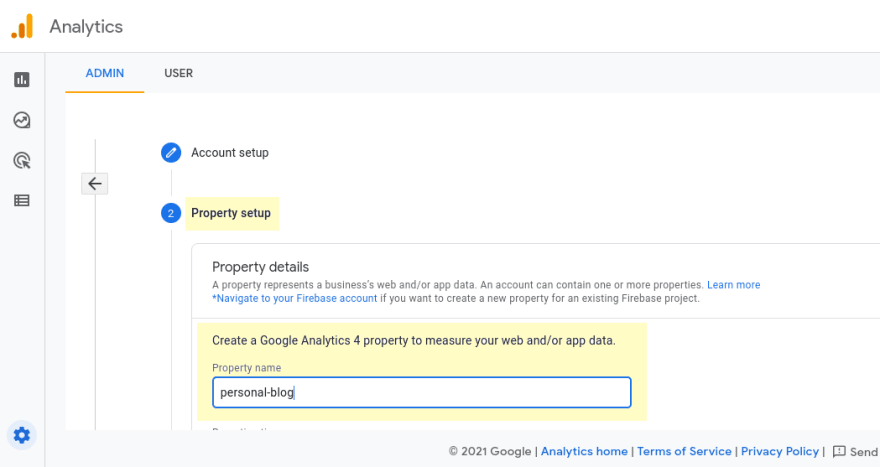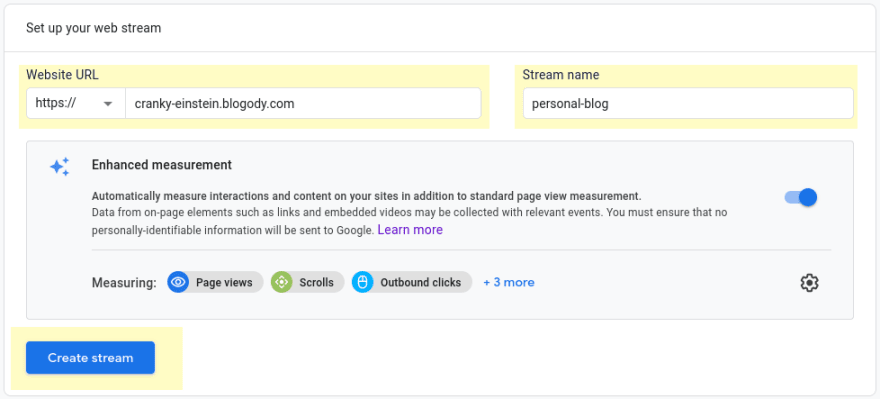A new Google Analytics integration feature has been added to Blogody today. Just log on to your Blogody account and you’ll find the new integration under Settings > Analytics. That’s the beauty of Software as a Service: no need to worry about updating or installing anything — new features are instantly available to you.
Google Analytics is the most widely used web analytics service on the web. The new Blogody integration allows you to track page views, user scroll, outbound clicks and other user engagements. The only prerequisite is a free Google Analytics account. The following six, easy-to-follow steps show how to create a new Google measurement ID and use it in Blogody to start tracking your site.
Note that you can track different Blogody blogs individually with different measurement IDs.
Step 1: Navigate to your Analytics Dashboard
I assume that you have already created a Google Account and are able to log on to your Google Analytics dashboard. For your Blogody blog, you’ll typically want to create a new analytics view. This is done by creating a new account (not to be confused with your Google Analytics account that you earlier logged on to).
Step 2: Create a new account
Click on the gear icon in the lower left corner of your dashboard which opens the Admin section. This is the place where you create a new account.
After clicking the Create Account button, you’ll see a new setup view, where you need to give your account a new name:
That’s the only information required on this page, but it’s interesting to spend a minute to review the Account Data Sharing settings. The settings do not influence your traffic measurement, but they do influence what data Google is allowed to share with others (including its own services).
Best privacy is achieved by deactivating all checkboxes in the section entitled account data sharing settings.
Click the Next button when your are done on this page.
Step 3: Create a new property
As long as you do not need to use different data sharing settings, you can have one account for all your web sites. You can separate your sites through *properties *as an account can contain one or more properties. Thus, your *property name *should represent the website or blog that you want to measure.
Optionally, you can set your timezone and local currency. Advanced settings are only for legacy options and can be ignored. Click Next to get to the next view where you are asked to provide your business information. This section does not need to be filled out and can be left empty. Just make sure to click the Create button at the end and accept the terms.
Step 4: Create a data stream
The Google set up flow redirects you to the Data Streams section which is part of your newly created property. To start collecting data for your blog, you must choose the web platform:
Fill in the blog URL which can be either your blogody.com domain (e.g. of the form https://subdomain.blogody.com) or your custom domain, if you configured one in Blogody.
The stream name serves a stream identifier and can be chosen arbitrarily. It’s a good idea is to take the subdomain for your stream name. Finally, hit the *Create stream *button.
Step 5: Disable history events
As you can see, a measurement ID has been created. That is the token you need to add to your blog in the Blogody platform. Before we do so, you must deactivate history event detection, otherwise you will get incorrect measurement results.
Click on the gear icon and a side menu opens. The history events options is hidden under advanced settings:
Deselect Page changes based on browser history events *and press Save.*
Blogody is build on NextJS which has a pushState in place for state management purposes. This push populates the history stack and would cause an additional page view fired if you leave the history event option toggled on.
Step 6: Add your measurement ID to Blogody
Finally, you can connect the generated measurement ID to your blog. Copy the ID to your clipboard, in the above example it would be G-ER92JRD0S5.
Log into your Blogody account, choose the blog project you want to start tracking and add the measurment ID under Settings > Analytics > Google Analytics as shown below.
Now everything is set up and you can start monitoring your analytics data 🎉
What’s next?
Are you looking for another integration or favor another analytics provider? Send me a message via the Feedback button in Blogody and let me know!
This post was originally published at Blogody News on August 18, 2021.















Top comments (0)